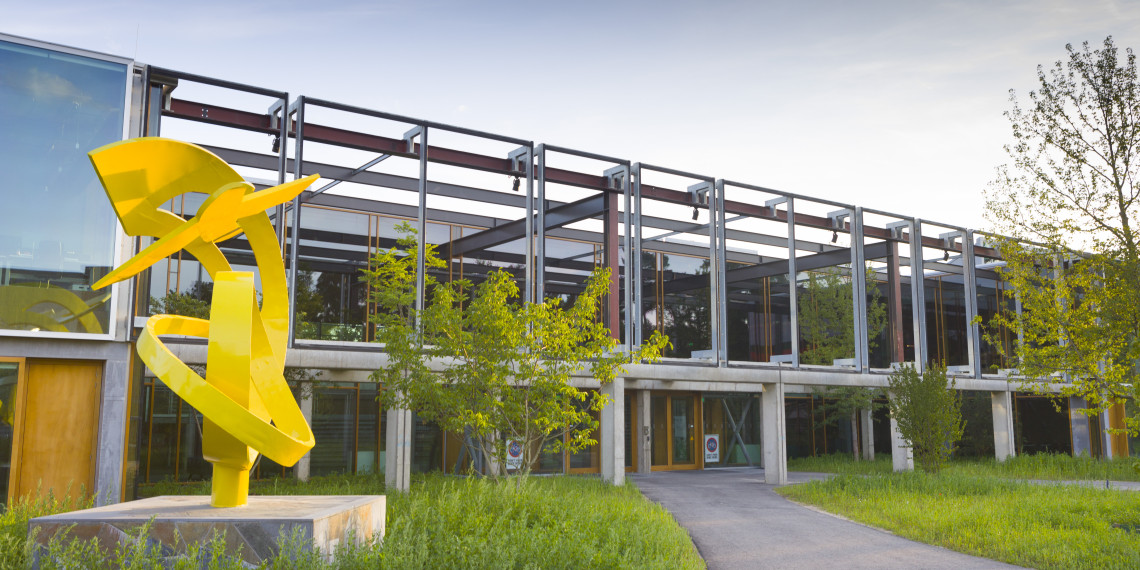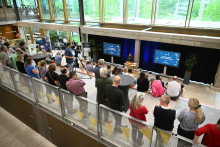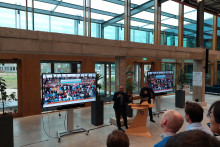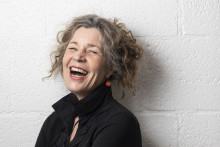It is a rite of passage for many an ITC graduate: the traditional graduation photo op at ‘de Kronkel’. A sculpture by Charles Hammes, which has served as ITC’s logo for many years: a wide continuous strip represents the earth, around which is flying a figure. Is it a bird? A plane? What we do know is that it symbolises aerial mapping.
ITC was officially founded on 11 July 1950, but the date of 17 December may be more important. That is the birthday of Willem Schermerhorn, who since 1926 had been professor of land surveying, levelling and geodesy at the then Technische Hogeschool Delft. Shortly after the end of the Second World War, he founded the ITC during a conference he organised. Its original name was the ‘International Training Centre for Aerial Survey’: a training institute focused on offering courses on cartography and aerial photography to people from developing countries. Over the years, the full name evolved to ‘International Institute for Aerial Survey and Earth Sciences’ and eventually to the ‘Faculty of Geo-Information Science and Earth Observation’ as it is known today. The fact that this name is such a tongue twister is no doubt the reason why the acronym ITC - International Training Centre - has stuck around for over 70 years.
On 11 July 1950, the establishment is a fact. The institute did not have its own building yet, so it was initially housed in the premises of the geodesy department of the Technische Hogeschool in Delft. Schermerhorn became the institute’s first rector, in the same building where he lived, on the Kanaalweg in Delft. Six years later, Prince Bernhard opened the ITC’s very own building on that same street, housing not only teaching facilities but also student residences. Founder Schermerhorn also moved into the new building himself and took up residence in the penthouse.
Willem Schermerhorn
Professor Willem (Wim) Schermerhorn became the Netherlands’ first prime minister after the Second World War in 1945, as the leader of a so-called emergency cabinet. This was because elections to the Lower House had yet to take place after the German occupation. Schermerhorn served as rector of ITC from 1950 to 1962. He passed away in 1977 at the age of 82.
Arranged marriage
So how did the institute come to be located in Enschede? This is rooted in a political choice; due to a dispersal policy implemented in the late 1960s, the eastern part of the Netherlands was to be strengthened socio-economically. This led to the decision to move part of the ITC to Enschede. And so, in 1971, part of the ITC moved into the old Twentec building on Boulevard 1945, right in the city centre. This time, the building was opened by Prince Claus. It was only in 2000 that the last ITC members made the switch from Delft to Enschede.
At that point, ITC had already been located in the building on Hengelosestraat for years. This building was opened in 1996 by Maha Chakri Sirindhorn, the princess of Thailand. Yet prior to the institute’s third move, there was a tentative flirtation with UT. Although it can also be interpreted as a plan for an arranged marriage. If it had been up to the Ministry of Education, Culture and Science in the late 1980s, ITC would already have moved to UT’s campus at that time. However, ITC - which had grown into a training and research institute of international repute – preferred to stay close to Enschede’s city centre.
The political pressure subsided for a while, but resurfaced around the turn of the millennium. Things were set in motion by the Higher Education and Research Plan (HOOP) of then education minister Loek Hermans. As one of five institutions for international education, ITC had to bind itself (administratively) to a university. After some initial indecision regarding the choice between UT and Utrecht University, the institute opted for its next-door neighbour as the coordinating organisation. Purely administrative or a first step towards closer cooperation? Martien Molenaar, rector of ITC at the time, had this to say: ‘Our autonomy is paramount. We will continue to be the ITC we are today. The secretariat is an administrative link, which is essentially just a formality.’
No matter how firmly put, Molenaar did hint that closer cooperation was an obvious choice. As it turned out, the secretariat was a first step towards the integration of ITC into UT. On 1 January 2010, the integration was a fact; ITC became the sixth UT faculty, a so-called faculty sui generis, unique in its kind but with the same authorisations as the other five faculties. Time for a new move? In 2010, UT Nieuws (U-Today’s predecessor) interviewed ITC’s brand-new dean Tom Veldkamp and presented him with the following dilemma: Hengelosestraat or Drienerlolaan? For now, ITC is at the right place, replied Veldkamp, now rector magnificus of the UT. ‘Eventually, ITC will probably be housed on campus, but that will take at least ten years. First, we will have to get the accommodation of our international students in order, at any rate.’

Photo: the former ITC building at the Hengelosestraat.
Musical chairs
Looking back with the knowledge of today, Veldkamp’s answer was quite an accurate estimation of the start of the fourth relocation process, which began to take shape in 2013. Both the Horst building and Technohal were being considered for future accommodation of the ITC faculty in that year. When the move would take place was not yet known at that time. Campus & Facility Management conducted a ‘feasibility assessment’.
A year later, the plans for the Horst or Technohal were scrapped. The Spiegel was now to be the ITC faculty’s new home. The Executive Board considered the building to be the ideal location for the ITC because it would give the campus a more international character, located prominently near the main entrance. In addition, it is clearly its own place, which is what the ITC was looking for, according to the Executive Board. But by 2016, the ITC faculty’s move to Spiegel was already in doubt. Over the next few months, the Board reassessed the accommodation plans, reported UT Nieuws. Apparently, ITC would prefer to move into one of the buildings surrounding O&O square.
The faculty's wish was granted that same year. ITC would move to Citadel and the health cluster would move to Technohal, according to this scenario. This was supposed to bring about a ‘spectacular change’ at the O&O square. A ‘sustainable and distinctive’ building with no less than thirteen floors was going to be erected for ITC right where Citadel is located, including a rooftop garden, managing director Erna Leurink hinted at the time.
But meanwhile, the market was picking up and construction prices were rising. In 2018, it became clear that the new construction plans for the ITC faculty would be temporarily shelved. Not much later, it turned out that the Citadel plans were completely off the table and ITC had to look for another location. There were three possible alternatives to consider at that point. 1: New construction near the O&O square. 2: The old Langezijds building. 3: Cancelling the move altogether.
They settled on option 2. In 2019, the proverbial die was cast. The ITC faculty would go to Langezijds, a 220-metre-long building that had been home to UT’s chemical engineers for years. And so, in three years’ time, the building transformed from vacant building to building site, to eventually a vibrant building with a ‘social heart’ and three courtyard gardens.
ITC faculty alumni
- The ITC faculty boasts more than 25,000 alumni. Alumni is used as a somewhat broader term here; anyone who has ever completed a course at ITC is counted.
- About three-quarters of the alumni group are from Africa or Asia and more than a quarter of ITC alumni are women.
- ITC alumni are spread across 177 countries worldwide.
A few notable ITC alumni:
- Siti Nurbaya Bakar (’88), Minister of Environment & Forestry in Indonesia since 2017.
- Wilber Otichilo (’82), governor of Vihiga County in Western Kenya since 2011.
- Vishnu Nandan (’12), was part of MOSAiC, the largest ever polar expedition.
- Daryll Mathew (’00), Minister of Education, Sports & Creative Industries in Antigua and Barbuda since 2020.
- Amon Murwira (’03), Minister of Higher Education, Science & Technology Development in Zimbabwe since 2019.
Capstone
As the first new residents moved in in spring 2023, an almost decade-long game of musical chairs finally comes to an end. But the job is done: ITC has been successfully moved to campus. In an earlier interview with U-Today, Annemarie Arets, who led the ITC working group as the project’s initiator, summarised it well: ‘The move is the ultimate capstone of ITC’s integration at UT.’
The training centre that became an institute. The institute that became a faculty. ITC moved a total of four times – sometimes reluctantly. Despite the ITC’s seemingly turbulent past, many of its staff will endorse the sense of community that has never faded away. The ‘ITC Family’ has long been a common adage. ‘But especially now that the move is behind us, I expect – and hope – that we will increasingly start using the phrase ‘UT Family’ instead, says current ITC dean Freek van der Meer. ‘Especially since 2010 – when we became much more academic – we've been gradually evolving from an institute into a faculty; this relocation is the final step in that process. The only thing that still sets our faculty apart from the others is that we’re a faculty with a mission and we’re partly funded by a different ministry.’
Despite this differing funding structure, the faculty sui generis has grown closer to ‘the rest’ of the university over the past decade. In terms of research, the BMS and ITC faculties were already trying to find each other in 2015 with ‘GeoHealth’, a theme that seems to be gradually gaining momentum now and also involves collaboration with the TechMed Centre. With regard to organisation, over the past few years, ITC was put in charge of University College Twente, as well as Pre-U, UT’s pre-university programme, among others. Education-wise, there was also quite a shift; whereas ITC’s core task as an institute and later as a faculty had been to provide knowledge to people from developing countries (often young professionals), the arrival of Spatial Engineering in 2018 saw the addition of a more ‘traditional’ master’s programme to its academic offering. ‘I hope the move will facilitate the desire to pursue even more collaboration with other faculties. Although this is already happening, I think that as a university we can further improve on that’, concludes Van der Meer. ‘After years of patience, we now have a prime position on campus. That’s truly something special.’

Photo: ITC students and employees at the new faculty building on campus.







